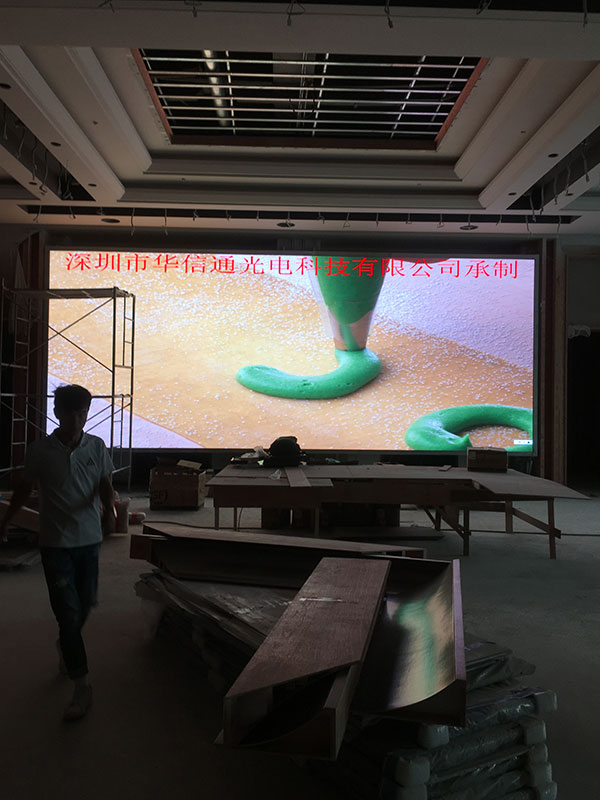The LED electronic large screen is packaged with thousands of light beads, and then assembled into a large screen by module splicing or box splicing. It is then connected to power, cables, and control cards before the screen can be lit up. It can be said that the stability of LED displays is related to the LED beads, power supply, and control card. So, what is the signal stability of high-definition LED displays related to? Below is a brief introduction from the manufacturer of Huaxintong Optoelectronics LED display screens.

What is the signal stability of high-definition LED display screens related to
The signal stability of high-definition LED display screens is related to signal attenuation, signal reflection in communication lines, distributed capacitance for bus transmission, and reliable communication protocols. If the LED electronic screen is interrupted during signal transmission, it will affect the operation of the entire screen, especially for live programs, large-scale stage performances, and other events. Therefore, in some major events, LED display manufacturers need to send technical support to escort. In addition, in the process of signal transmission, the larger the distance, the weaker the signal, so the transmission medium is very important. Generally speaking, cables can be used for transmission within 100 meters, while fiber optic cables can be used for transmission beyond 100 meters.
1. Signal attenuation can affect the stability of screen signals
Regardless of the transmission medium, attenuation will occur during the transmission process. Generally speaking, RS-485 transmission cables are regarded as equivalent electrical energy composed of several resistors, inductors, and capacitors, and the resistance of the wires has little effect on the signal and can be ignored. The distributed capacitance C of the cable is mainly caused by the two parallel wires of the twisted pair, and the signal loss is mainly due to the LC low-pass filter composed of the distributed capacitance and distributed inductance of the cable. The higher the communication baud rate, the greater the signal attenuation. Therefore, when the amount of data transmitted is not very large and the transmission rate requirement is not very high, we generally choose a baud rate of 9600 bps.
2. Signal reflection in communication lines
In addition to signal attenuation, another factor that affects signal transmission is signal reflection. Impedance mismatch and impedance discontinuity are the two main reasons for signal reflection in the bus. One is impedance mismatch, which mainly refers to the impedance mismatch between the 485 chip and the communication line. The reason for the reflection is that when the communication line is idle, the entire communication line signal is chaotic. Once such a reflected signal triggers the comparator at the input of the 485 chip, an erroneous signal will occur. Our general solution is to add bias resistors with a certain resistance value to the A and B lines of the bus, pulling them high and low separately, so that unpredictable chaotic signals will not occur.
The second is impedance discontinuity, which is similar to the reflection caused by light entering another medium from one medium. When the signal accidentally encounters a cable with low or no impedance at the end of the transmission line, it will cause reflection at this location. The most commonly used method to eliminate this reflection is to cross connect a terminal resistor of the same size as the characteristic impedance of the cable at the end of the cable, making the impedance of the cable continuous. Due to the bidirectional transmission of signals over cables, a terminal resistor of the same size must be connected across the other end of the communication cable.
3. The influence of distributed capacitance on bus transmission function
Transmission cables are generally twisted pair cables, and capacitance occurs between the two parallel wires of twisted pair cables. There is also a similar small capacitance between cables and the earth. Due to the fact that the signals transmitted on the bus are composed of many "1" and "0" bits, when encountering special bytes such as 0x01, the level "0" allows the distributed capacitor to charge in a sufficient time. However, when the level "1" accidentally comes into contact, the accumulated charge in the capacitor cannot be discharged in a short period of time, resulting in the deformation of the signal bits and affecting the quality of the entire data transmission.
4. Develop a concise and reliable communication protocol
When the communication distance is short and the application environment is less troublesome, sometimes we only need simple one-way communication to complete all the functions of the project, but this is not the case for most application environments. Whether the wiring in the early stage of the project is professional (such as maintaining a certain distance between signal lines and power lines), the unpredictability of communication distance, the degree of disturbance around communication lines, and whether twisted pair shielded wires are used for communication lines, all of these factors have a great impact on the normal communication of the system. So, it is particularly important to develop a comprehensive communication protocol.